Raman Spectroscopy of Graphene/CNT Layers Deposited on Interdigit Sensors for Application in Gas Detection
Abstract
:1. Introduction
2. Materials and Methods
2.1. Materials
2.2. Formation of the Interdigital Si/SiO2/Ti/Pt Sensor
2.3. Deposition of Graphene/CNT Layers
2.4. Characterization Methods
3. Results
3.1. Raman Spectroscopy Analysis
3.2. X-Ray Diffraction Analysis
3.3. SEM-Analysis
3.4. Electrical and Gas Testing Measurements
4. Discussions and Future Directions
5. Conclusions
Author Contributions
Funding
Data Availability Statement
Acknowledgments
Conflicts of Interest
References
- Cott, D.J.; Verheijen, M.; Richard, O.; Radu, I.; Gendt, S.D.; van Elshocht, S.; Vereecken, P.M. Synthesis of large area carbon nanosheets for energy storage applications. Carbon 2013, 58, 59–65. [Google Scholar] [CrossRef]
- Novoselov, K.S.; Geim, A.K.; Morozov, S.V.; Jiang, D.; Zhang, Y.; Dubonos, S.V.; Grigorieva, I.V.; Firsov, A.A. Electric Field Effect in Atomically Thin Carbon Films. Science 2004, 306, 666–669. [Google Scholar] [CrossRef] [PubMed]
- Vansweevelt, R.; Malesevic, A.; Van Gompel, M.; Vanhulsel, A.; Wenmackers, S.; D’Haen, J.; Vermeeren, V.; Ameloot, M.; Michiels, L.; Van Haesendonck, C.; et al. Biological modification of carbon nanowalls with DNA strands and hybridization experiments with complementary and mismatched DNA. Chem. Phys. Lett. 2010, 485, 196–201. [Google Scholar] [CrossRef]
- Rabchinskii, M.K.; Sysoev, V.V.; Glukhova, O.E.; Brzhezinskaya, M.; Stolyarova, D.Y.; Varezhnikov, A.S.; Solomatin, M.A.; Barkov, P.V.; Kirilenko, D.A.; Pavlov, S.I.; et al. Guiding graphene derivatization for the on-chip multisensory arrays: From the synthesis to the theoretical background. Adv. Mater. Technol. 2022, 7, 2101250. [Google Scholar] [CrossRef]
- Iordache, S.-M.; Ionete, E.I.; Iordache, A.-M.; Stamatin, I.; Zoita, N.C.; Sobetkii, A.; Grigorescu, C.E.A. Functionalized Carbon Nanotubes for Chemical Sensing: Electrochemical Detection of Hydrogen Isotopes. Coatings 2021, 11, 968. [Google Scholar] [CrossRef]
- Iordache, S.M.; Ionete, E.I.; Iordache, A.M.; Tanasa, E.; Stamatin, I.; Grigorescu, C.E.A. Pd-decorated CNT as sensitive material for applications in hydrogen isotopes sensing—Application as gas sensor. Int. J. Hydrogen Energy 2021, 46, 11015–11024. [Google Scholar] [CrossRef]
- Zubarev, A.; Cuzminschi, M.; Iordache, A.-M.; Iordache, S.-M.; Rizea, C.; Grigorescu, C.E.A.; Giuglea, C. Graphene-Based Sensor for the Detection of Cortisol for Stress Level Monitoring and Diagnostics. Diagnostics 2022, 12, 2593. [Google Scholar] [CrossRef]
- Iordache, S.-M.; Iordache, A.-M.; Zubarev, A.; Caramizoiu, S.; Grigorescu, C.E.A.; Marinescu, S.; Giuglea, C. Spectro-Electrochemical Properties of a New Non-Enzymatic Modified Working Electrode Used for Histamine Assessment in the Diagnosis of Food Poisoning. Foods 2023, 12, 2908. [Google Scholar] [CrossRef]
- Wu, Y.H.; Yu, T.; Shen, Z.X. Two-dimensional carbon nanostructures: Fundamental properties, synthesis, characterization, and potential applications. J. Appl. Phys. 2010, 108, 071301. [Google Scholar] [CrossRef]
- Kobayashi, K.; Tanimura, M.; Nakai, H.; Yoshimura, A.; Yoshimura, H.; Kojima, K.; Tachibana, M. Nanographite domains in carbon nanowalls. J. Appl. Phys. 2007, 101, 094306. [Google Scholar] [CrossRef]
- Bita, B.; Vizireanu, S.; Stoica, D.; Ion, V.; Yehia, S.; Radu, A.; Iftimie, S.; Dinescu, G. On the Structural, Morphological, and Electrical Properties of Carbon Nanowalls Obtained by Plasma-Enhanced Chemical Vapor Deposition. J. Nanomater. 2020, 2020, e8814459. [Google Scholar] [CrossRef]
- Lee, K.-Y.; Ikuno, T.; Tsuji, K.; Ohkura, S.; Honda, S.; Katayama, M.; Oura, K.; Hirao, T. Synthesis of aligned bamboo-like carbon nanotubes using radio frequency magnetron sputtering. J. Vac. Sci. Technol. B Microelectron. Nanometer Struct. Process. Meas. Phenom. 2003, 21, 1437–1441. [Google Scholar] [CrossRef]
- Choi, H.; Kwon, S.; Kang, H.; Kim, J.H.; Choi, W. Adhesion-Increased Carbon Nanowalls for the Electrodes of Energy Storage Systems. Energies 2019, 12, 4759. [Google Scholar] [CrossRef]
- Sahu, P.K.; Pandey, R.K.; Dwivedi, R.; Mishra, V.N.; Prakash, R. Polymer/Graphene oxide nanocomposite thin film for NO2 sensor: An in situ investigation of electronic, morphological, structural, and spectroscopic properties. Sci. Rep. 2020, 10, 2981. [Google Scholar] [CrossRef]
- Guzmán-Olivos, F.; Espinoza-González, R.; Fuenzalida, V. Nanocrystalline carbon flakes deposited by RF magnetron sputtering. Mater. Lett. 2016, 167, 242–245. [Google Scholar] [CrossRef]
- Scalese, S.; Scuderi, V.; Privitera, V.; Pennisi, A.; Simone, F. Simultaneous catalyst deposition and growth of aligned carbon nanotubes on SiO2/Si substrates by radio frequency magnetron sputtering. J. Appl. Phys. 2007, 102, 114905. [Google Scholar] [CrossRef]
- Dreghici, D.B.; Butoi, B.; Predoi, D.; Iconaru, S.L.; Stoican, O.; Groza, A. Chitosan–Hydroxyapatite Composite Layers Generated in Radio Frequency Magnetron Sputtering Discharge: From Plasma to Structural and Morphological Analysis of Layers. Polymers 2020, 12, 3065. [Google Scholar] [CrossRef]
- Ren, X.; Zhu, H.; Liu, N.; Wei, Q.; Pu, J.; Ma, L.; Wang, Y.; Xie, Y.; Wei, B.; Yu, Z.; et al. Hydrogenated diamond-like carbon film prepared by RF bias assisting magnetron sputtering. Mater. Res. Express 2019, 6, 076403. [Google Scholar] [CrossRef]
- Shapovalov, V.I.; Komlev, A.E.; Bondarenko, A.S.; Baykov, P.B.; Karzin, V.V. Substrate heating and cooling during magnetron sputtering of copper target. Phys. Lett. A 2016, 380, 882–885. [Google Scholar] [CrossRef]
- Manguele, J.J.; Baudouin, F.; Cibert, C.; Domenges, B.; Demange, V.; Guilloux-Viry, M.; Fouchet, A.; Poullain, G. Orientation control of Platinum electrode grown on silicon using [Ca2Nb3O10]–nanosheets as seed layer. Thin Solid Films 2023, 765, 139640. [Google Scholar] [CrossRef]
- Groza, A.; Dreghici, D.B.; Ganciu, M. Calcium Phosphate Layers Deposited on Thermal Sensitive Polymer Substrates in Radio Frequency Magnetron Plasma Discharge. Coatings 2019, 9, 709. [Google Scholar] [CrossRef]
- Kononenko, O.; Brzhezinskaya, M.; Zotov, A.; Korepanov, V.; Levashov, V.; Matveev, V.; Roshchupkin, D. Influence of numerous Moire superlattices on transport properties of twisted multilayer graphene. Carbon 2022, 194, 52–61. [Google Scholar] [CrossRef]
- Tüzemen, E.Ş.; Kilic, M.; Zeyrek, B.K.; Kasapoglu, A.E.; Gür, E.; Alaydin, B.O.; Esen, M.; Esen, R. Formation of carbon nanowalls by pulsed filtered cathodic vacuum arc deposition. Diam. Relat. Mater. 2019, 93, 200–207. [Google Scholar] [CrossRef]
- Adhikari, B.; Majumdar, S. Polymers in sensor applications. Prog. Polym. Sci. 2004, 29, 699–766. [Google Scholar] [CrossRef]
- Jorio, A.; Saito, R. Raman spectroscopy for carbon nanotube applications. J. Appl. Phys. 2021, 129, 021102. [Google Scholar] [CrossRef]
- Lin, C.-C.; Shen, Y.-L.; Wu, A.-N. The Effects of Power Levels/Time Periods for Sputtering Cobalt onto Carbon Nanotubes/Graphene Composites and Cobalt Annealed on the Characteristics of Anode Materials for Lithium-Ion Batteries. J. Nanomater. 2018, 2018, e9489042. [Google Scholar] [CrossRef]
- Ionescu, M.I.; Sun, X.; Luan, B. Multilayer graphene synthesized using magnetron sputtering for planar supercapacitor application. Can. J. Chem. 2015, 93, 160–164. [Google Scholar] [CrossRef]
- Maniwa, Y.; Fujiwara, R.; Kira, H.; Tou, H.; Kataura, H.; Suzuki, S.; Achiba, Y.; Nishibori, E.; Takata, M.; Sakata, M.; et al. Thermal expansion of single-walled carbon nanotube (SWNT) bundles: X-ray diffraction studies. Phys. Rev. B 2001, 64, 241402. [Google Scholar] [CrossRef]
- Surmenev, R.A.; Surmeneva, M.A.; Evdokimov, K.E.; Pichugin, V.F.; Peitsch, T.; Epple, M. The influence of the deposition parameters on the properties of an rf-magnetron-deposited nanostructured calcium phosphate coating and a possible growth mechanism. Surf. Coat. Technol. 2011, 205, 3600–3606. [Google Scholar] [CrossRef]
- Chen, Z.; Wang, J.; Cao, N.; Wang, Y.; Li, H.; Rooij, N.F.D.; Umar, A.; Feng, Y.; French, P.J.; Zhou, G. Three-Dimensional Graphene-Based Foams with “Greater Electron Transferring Areas” Deriving High Gas Sensitivity. ACS Appl. Nano Mater. 2021, 4, 13234–13245. [Google Scholar] [CrossRef]
- Mao, Y.; Liu, S.; Liu, S.; Wu, G.; Liu, Q.; Du, X. Synergistic effect of CNT and N-Doped graphene foam on improving the corrosion resistance of ZN reinforced epoxy composite coatings. Polymers 2024, 16, 3513. [Google Scholar] [CrossRef]
- Mbayachi, V.B.; Ndayiragije, E.; Sammani, T.; Taj, S.; Mbuta, E.R.; Khan, A.U. Graphene synthesis, characterization and its applications: A review. Results Chem. 2021, 3, 100163. [Google Scholar] [CrossRef]
- Peng, Z.; Ng, A.L.; Kwon, H.; Wang, P.; Chen, C.F.; Lee, C.S.; Wang, Y. Graphene as a functional layer for semiconducting carbon nanotube transistor sensors. Carbon 2017, 125, 49–55. [Google Scholar] [CrossRef] [PubMed]
- Schroeder, V.; Savagatrup, S.; He, M.; Lin, S.; Swager, T.M. Carbon Nanotube Chemical Sensors. Chem. Rev. 2019, 119, 599–663. [Google Scholar] [CrossRef] [PubMed]
- Snyder, G.; Toberer, E. Complex thermoelectric materials. Nat. Mater. 2008, 7, 105–114. [Google Scholar] [CrossRef]
- Liang, Q.; Yao, X.; Wang, W.; Liu, Y.; Wong, C.P. A Three-Dimensional Vertically Aligned Functionalized Multilayer Graphene Architecture: An Approach for Graphene-Based Thermal Interfacial Materials. ACS Nano 2011, 5, 2392–2401. [Google Scholar] [CrossRef]
- Shen, X.; Opulente, D.A.; Kominek, J.; Zhou, X.; Steenwyk, J.L.; Buh, K.V.; Haase, M.A.; Wisecaver, J.H.; Wang, M.; Doering, D.T.; et al. Tempo and Mode of Genome Evolution in the Budding Yeast Subphylum. Cell 2018, 175, 1533–1545.e20. [Google Scholar] [CrossRef]
- Kumar, S.; Kolassa, J.; Reichle, R.; Crow, W.; de Lannoy, G.; de Rosnay, P.; MacBean, N.; Girotto, M.; Fox, A.; Quaife, T.; et al. An agenda for land data assimilation priorities: Realizing the promise of terrestrial water, energy, and vegetation observations from space. J. Adv. Model. Earth Syst. 2022, 14, e2022MS003259. [Google Scholar] [CrossRef]
- Kong, J.; Franklin, N.R.; Zhou, C.; Chapline, M.G.; Peng, S.; Cho, K.; Dai, H. Nanotube Molecular Wires as Chemical Sensors. Science 2000, 287, 622–625. [Google Scholar] [CrossRef]
- Park, S.; Vosguerichian, M.; Bao, Z. A review of fabrication and applications of carbon nanotube film-based flexible electronics. Nanoscale 2013, 5, 1727–1752. [Google Scholar] [CrossRef]
- Zhao, M.; Tian, Y.; Yan, L.; Liu, R.; Chen, P.; Wang, H.; Chu, W. Unique modulation effects on the performance of graphene-based ammonia sensors via ultrathin bimetallic Au/Pt layers and gate voltages. Phys. Chem. Chem. Phys. 2023, 25, 19764–19772. [Google Scholar] [CrossRef] [PubMed]
- He, Q.; Wu, S.; Yin, Z.; Zhang, H. Graphene-based electronic sensors. Chem. Sci. 2012, 3, 1764–1772. [Google Scholar] [CrossRef]
- Karimi, H.; Rahmani, R.; Akbari, E.; Rahmani, M.; Ahamdi, M.T. Optimization of Current-Voltage Characteristics of Graphene-Based Biosensors. In Handbook of Research on Nanoelectronic Sensor Modeling and Applications; Ahmadi, M.T., Ismail, R., Anwar, S., Eds.; IGI Global: Hershey PA, USA, 2017; pp. 244–264. [Google Scholar] [CrossRef]
- Xu, J.; Wang, Y.; Hu, S. Nanocomposites of graphene and graphene oxides: Synthesis, molecular functionalization and application in electrochemical sensors and biosensors. A review. Microchim. Acta 2017, 184, 1–44. [Google Scholar] [CrossRef]
- Hayasaka, T.; Lin, A.; Copa, V.C.; Lopez, L.P., Jr.; Loberternos, R.A.; Ballesteros, L.I.M.; Kubota, Y.; Liu, Y.; Salvador, A.A.; Lin, L. An electronic nose using a single graphene FET and machine learning for water, methanol, and ethanol. Microsyst. Nanoeng. 2020, 6, 50. [Google Scholar] [CrossRef]
- Islam, M.H.; Afroj, S.; Uddin, M.A.; Andreeva, D.V.; Novoselov, K.S.; Karim, N. Graphene and CNT-Based Smart Fiber-Reinforced Composites: A Review. Adv. Funct. Mater. 2022, 32, 2205723. [Google Scholar] [CrossRef]
- Jomol, P.J.; Mary Nancy, T.E.; Bindu Sharmila, T.K. A comprehensive review on the environmental applications of graphene–carbon nanotube hybrids: Recent progress, challenges and prospects. Mater. Adv. 2021, 2, 6816–6838. [Google Scholar] [CrossRef]
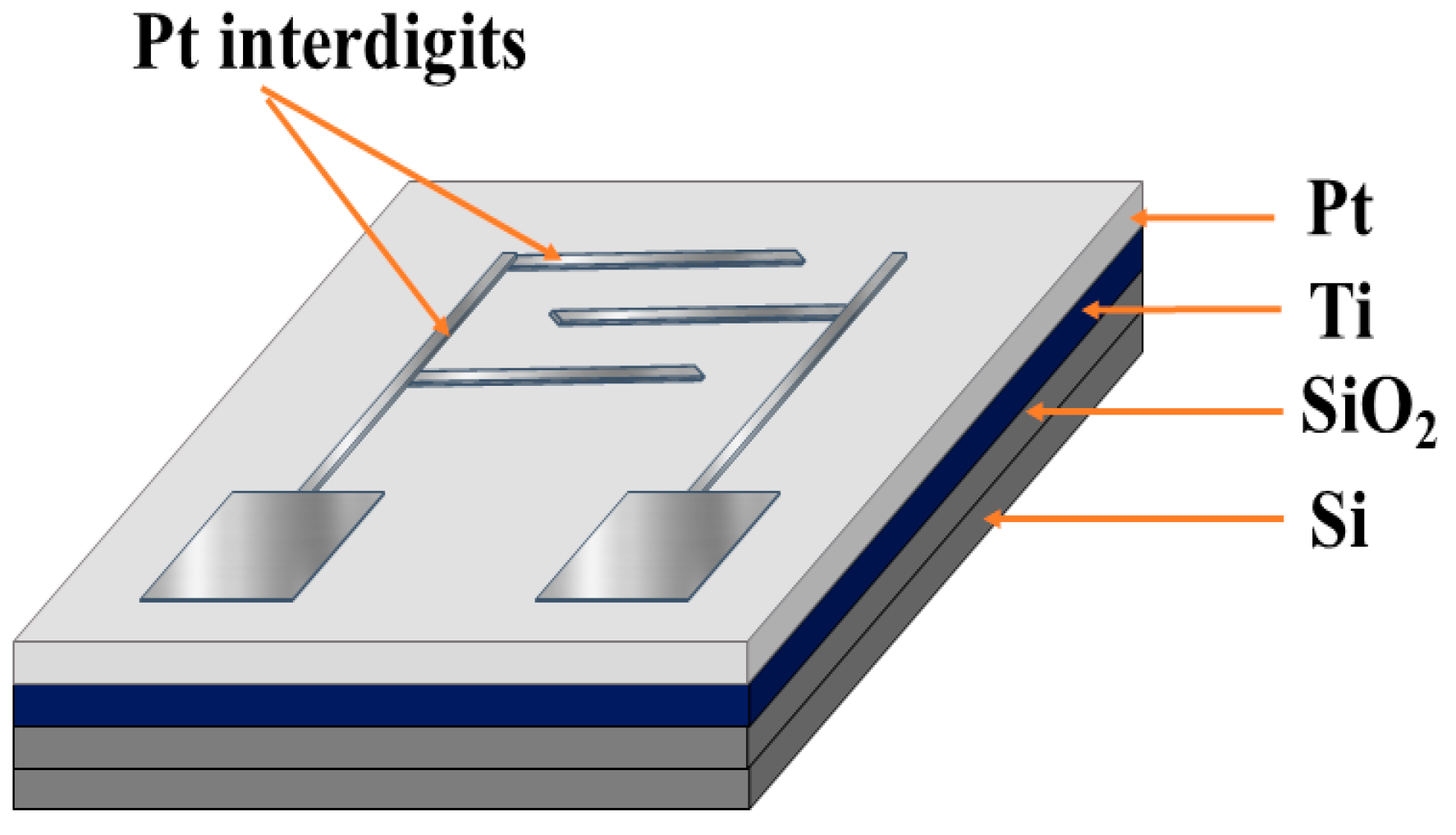
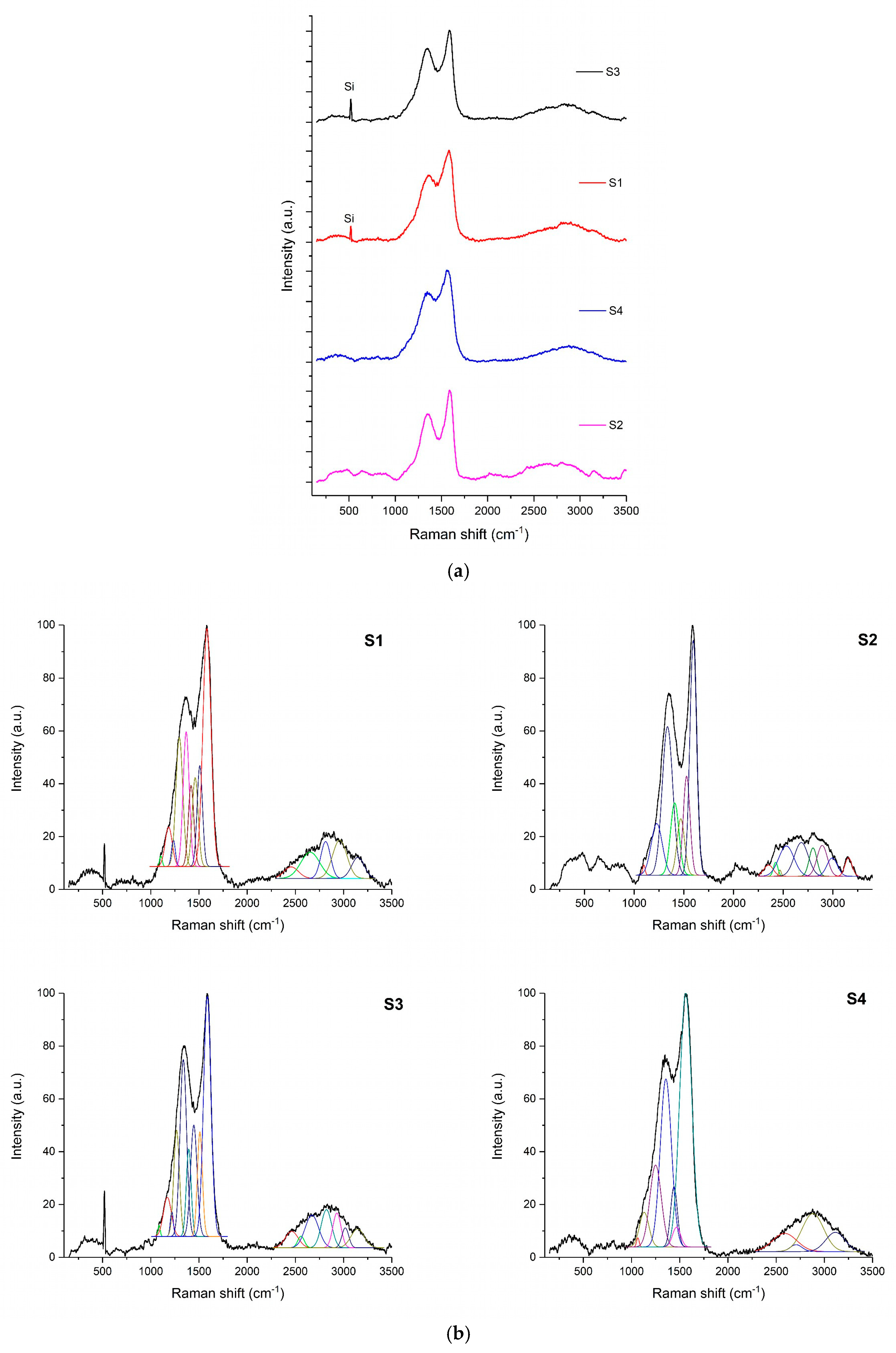
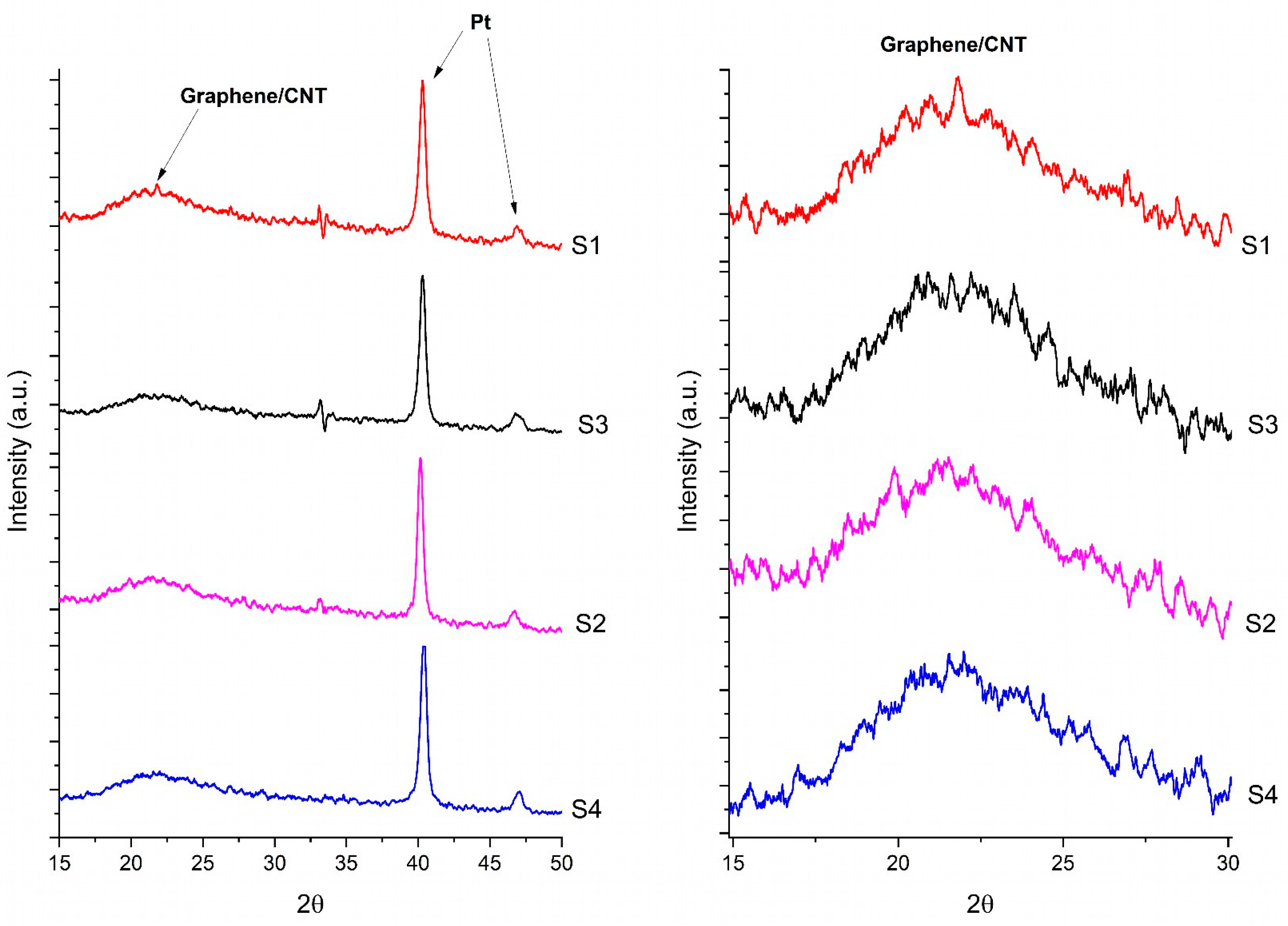
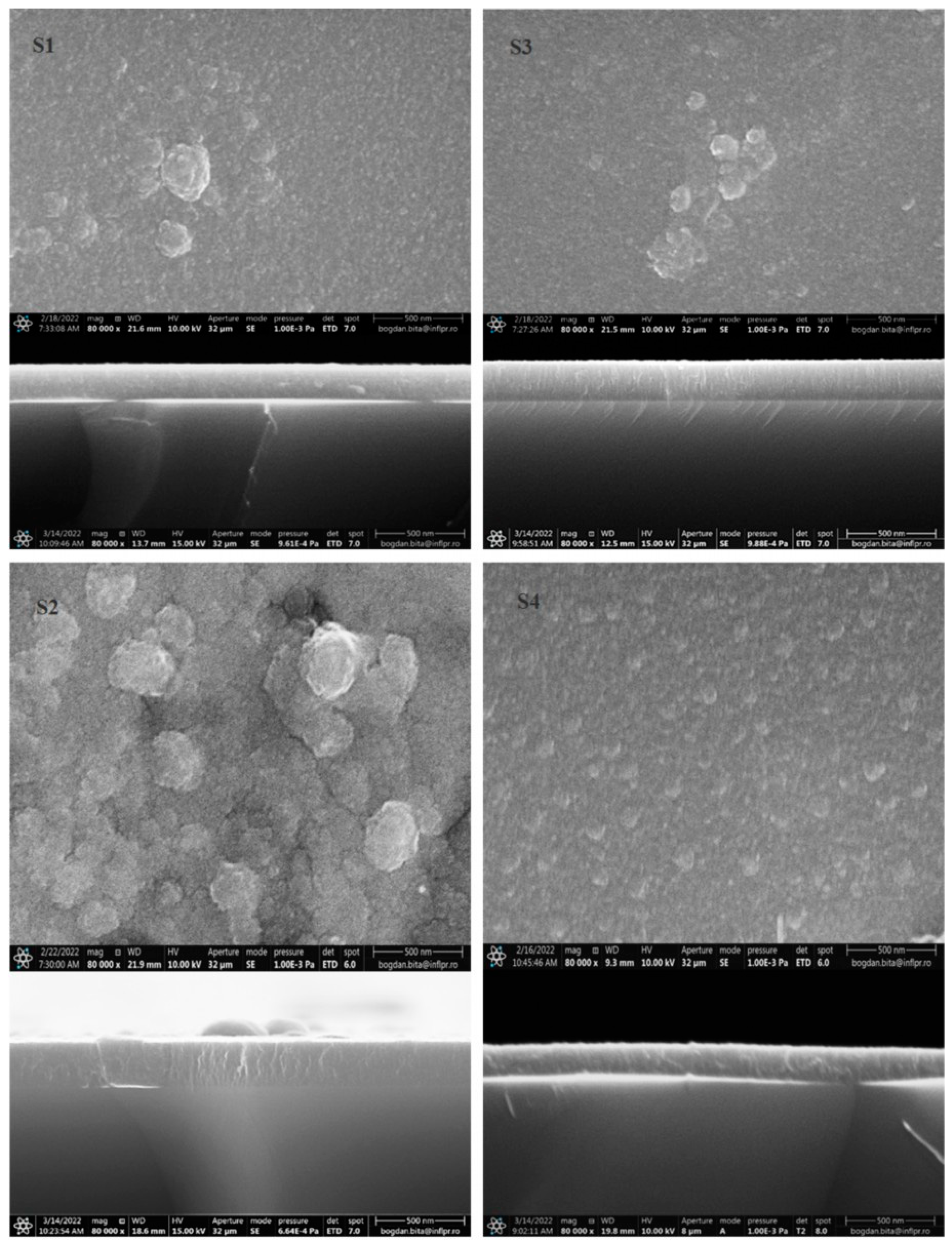
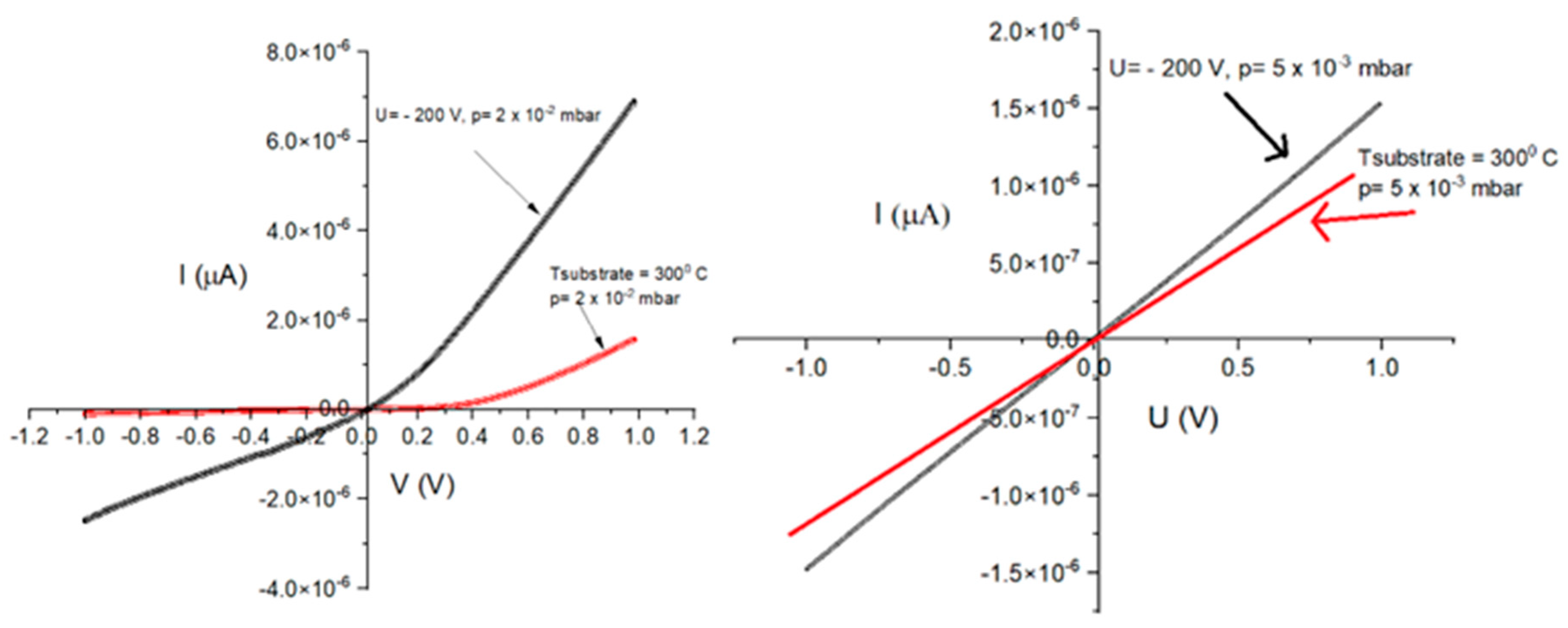

| Sample Code | Experimental Parameters | ||
|---|---|---|---|
| Voltage Bias [U (V)] | Temperature [Tsubstrate (°C)] | Pressure [P (mbar)] | |
| S1 | −200 | RT | 2 × 10−2 |
| S2 | 0 | 300 | |
| S3 | −200 | RT | 5 × 10−3 |
| S4 | 0 | 300 | |
| Sample | ID/IG | I2D/IG |
|---|---|---|
| S1 | 0.60 | 0.15 |
| S2 | 0.61 | 0.17 |
| S3 | 0.75 | 0.16 |
| S4 | 0.68 | 0.18 |
Disclaimer/Publisher’s Note: The statements, opinions and data contained in all publications are solely those of the individual author(s) and contributor(s) and not of MDPI and/or the editor(s). MDPI and/or the editor(s) disclaim responsibility for any injury to people or property resulting from any ideas, methods, instructions or products referred to in the content. |
© 2025 by the authors. Licensee MDPI, Basel, Switzerland. This article is an open access article distributed under the terms and conditions of the Creative Commons Attribution (CC BY) license (https://creativecommons.org/licenses/by/4.0/).
Share and Cite
Iordache, S.-M.; Iordache, A.-M.; Florea, A.-M.; Caramizoiu, S.; Parvulescu, C.; Baiasu, F.; Negut, I.; Bita, B. Raman Spectroscopy of Graphene/CNT Layers Deposited on Interdigit Sensors for Application in Gas Detection. C 2025, 11, 9. https://doi.org/10.3390/c11010009
Iordache S-M, Iordache A-M, Florea A-M, Caramizoiu S, Parvulescu C, Baiasu F, Negut I, Bita B. Raman Spectroscopy of Graphene/CNT Layers Deposited on Interdigit Sensors for Application in Gas Detection. C. 2025; 11(1):9. https://doi.org/10.3390/c11010009
Chicago/Turabian StyleIordache, Stefan-Marian, Ana-Maria Iordache, Ana-Maria Florea (Raduta), Stefan Caramizoiu, Catalin Parvulescu, Flaviu Baiasu, Irina Negut, and Bogdan Bita. 2025. "Raman Spectroscopy of Graphene/CNT Layers Deposited on Interdigit Sensors for Application in Gas Detection" C 11, no. 1: 9. https://doi.org/10.3390/c11010009
APA StyleIordache, S.-M., Iordache, A.-M., Florea, A.-M., Caramizoiu, S., Parvulescu, C., Baiasu, F., Negut, I., & Bita, B. (2025). Raman Spectroscopy of Graphene/CNT Layers Deposited on Interdigit Sensors for Application in Gas Detection. C, 11(1), 9. https://doi.org/10.3390/c11010009








